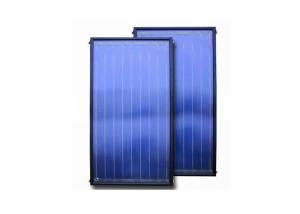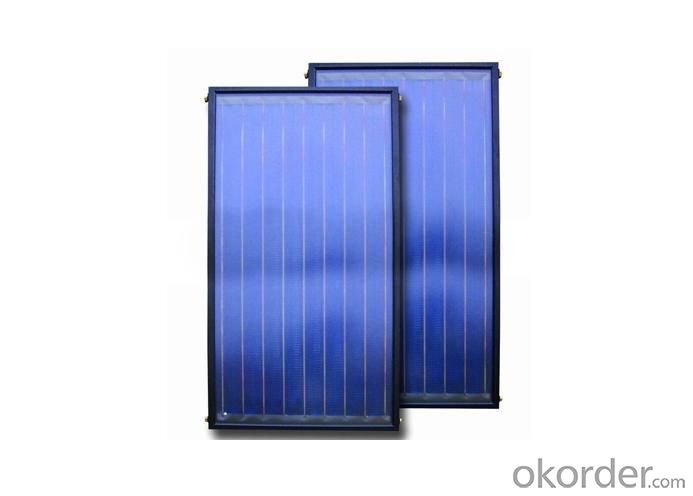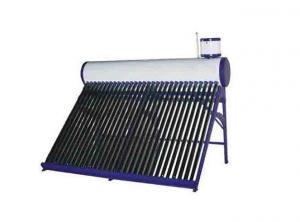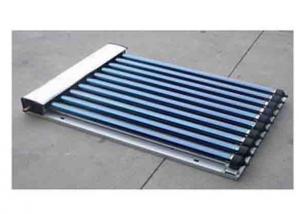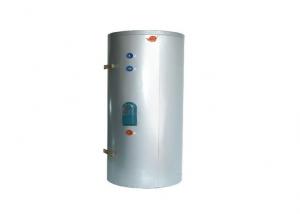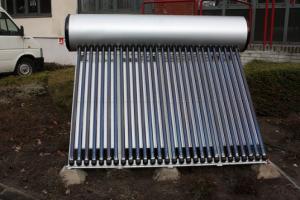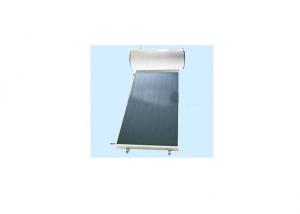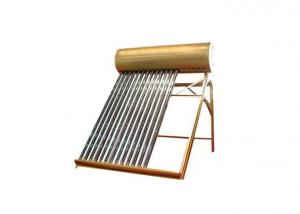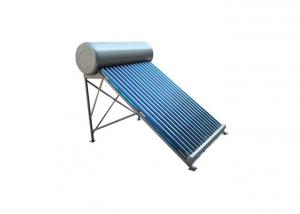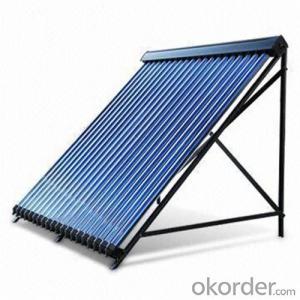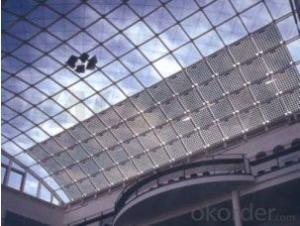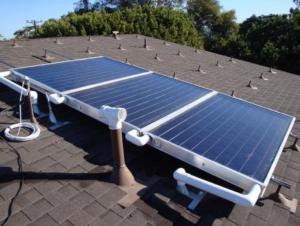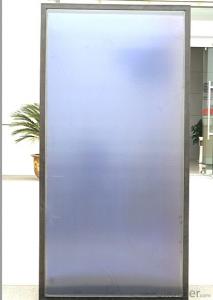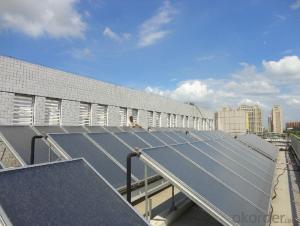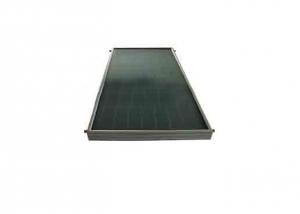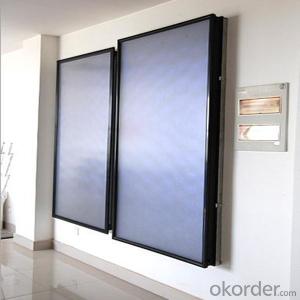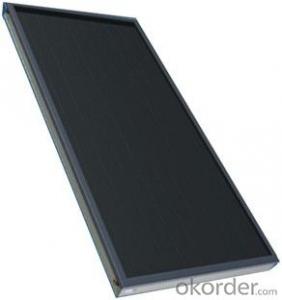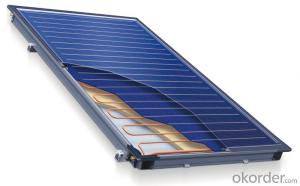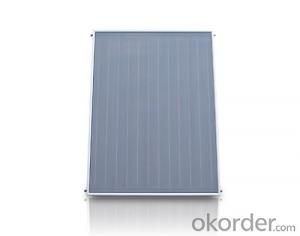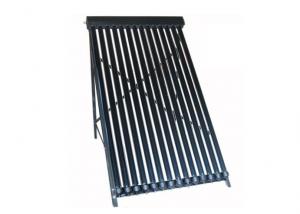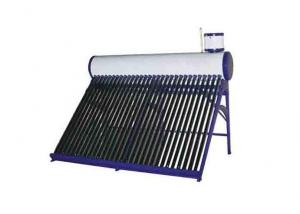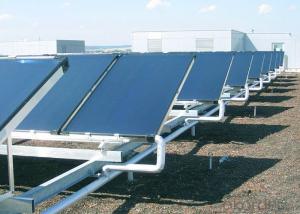Glazed Flat Plate Solar Collector
- Loading Port:
- China Main Port
- Payment Terms:
- TT or LC
- Min Order Qty:
- 1 Piece pc
- Supply Capability:
- 5000 Pieces per Month pc/month
OKorder Service Pledge
OKorder Financial Service
You Might Also Like
flat plate solar collector:
1)high quality
2)the most competitive price
3)best service
Specification of flat plate solar collector:
1)Dimension:2000%*1060*70
2)Gross area: 2 m2
3)Absorb area:1.8 m2
4)Conversion factor:78.5η%
5)Fluit content:2.2L
6)Maxmium operating pressure:1MPA
7)Temperature of operation:35-150 oC
8)Net weighte:32 KG/ PCS
9)Core: all cooper, ultrasonic welding
10)Coating: highly selective titanium coating from Germany
11)Abosorbe material:cooper
12)Header pipe ,material: copper
13)Materila of glass: tempered glass
14)Dimension of glass sheet:1988mm*988mm
15)Material of frame: aluminum alloy
16)Color of frame: champagne/brone-colored/white
17)Insulation : material, high pressure, high density polyrethane foam
18) Thickness of insulation :30mm/40mm/50mm
19)Material and thickness of black sheet:embossed aluminum blacksheet o.3mm
20)Cover sealing material:EPDM+ metal
21)Packing dimension:2020mm*1100*160mm
- Q: How do solar collectors affect air quality?
- Harnessing the sun's energy, solar collectors positively impact air quality by generating electricity or heat without emitting harmful pollutants. Unlike fossil fuel power plants, they do not release greenhouse gases like carbon dioxide, nitrogen oxides, or sulfur dioxide that contribute to air pollution and climate change. By reducing reliance on fossil fuels, solar collectors minimize harmful pollutant emissions, improving air quality. Moreover, they produce no noise pollution, further enhancing their environmental benefits. Consequently, solar collectors are a sustainable and clean energy solution that significantly improves air quality and mitigates the negative effects of traditional energy sources on the environment.
- Q: How do solar collectors impact cultural heritage?
- Cultural heritage can be affected both positively and negatively by the presence of solar collectors. On the positive side, solar collectors contribute to the use of renewable energy sources, reducing our reliance on fossil fuels and aiding in the fight against climate change. This is particularly important for the preservation of cultural heritage sites that are vulnerable to the consequences of global warming, such as rising sea levels or extreme weather events. Furthermore, solar collectors offer a sustainable energy solution for cultural heritage sites situated in remote areas without access to the electricity grid. This enables the preservation and exhibition of artifacts and structures that require electricity, such as lighting or temperature control systems, without the need for disruptive infrastructure development. However, the visual impact of solar collectors on cultural heritage sites must be carefully considered. These sites often possess unique architectural or natural beauty that can be compromised by the presence of large solar panels. Preservationists and architects must thoughtfully incorporate solar collectors into the design of heritage sites to ensure minimal disruption to their aesthetics and cultural significance. Additionally, the installation of solar collectors should be executed in a manner that respects the historical importance of the site and does not compromise its authenticity. This entails placing solar collectors in non-intrusive locations and ensuring that they do not harm or alter the original structures or landscapes. In conclusion, solar collectors have the potential to positively affect cultural heritage by promoting sustainability and offering energy solutions for remote sites. However, careful planning and integration are essential to guarantee that their installation does not compromise the visual, historical, and cultural value of these sites.
- Q: How long do solar collectors last?
- Solar collectors typically have a lifespan of 25 to 30 years, but with proper maintenance and care, they can continue to function efficiently for even longer periods.
- Q: Can solar collectors be used for generating electricity on home appliances?
- Yes, solar collectors can be used for generating electricity on home appliances. Solar collectors, also known as solar panels, convert sunlight into electricity through photovoltaic cells. This electricity can be used to power various home appliances, reducing reliance on traditional energy sources and promoting sustainability.
- Q: Can solar collectors be used in all climates?
- Solar collectors can be used in all climates, although their effectiveness may vary depending on the amount of available sunlight. In regions with high levels of sunlight, such as deserts, solar collectors can be highly efficient. However, even in colder or cloudier climates, solar collectors can still generate some energy, albeit at a lower rate.
- Q: Can solar collectors be used for heating wineries and breweries?
- Yes, solar collectors can be used for heating wineries and breweries. Solar thermal technology can be employed to capture and convert the sun's energy into heat, which can then be utilized for various heating purposes in wineries and breweries. This environmentally friendly and cost-effective solution can help reduce reliance on conventional heating methods and contribute to sustainable operations in these industries.
- Q: Can solar collectors be used in sustainable communities?
- Yes, solar collectors can definitely be used in sustainable communities. Solar collectors, such as solar panels, are a clean and renewable source of energy that can help reduce reliance on fossil fuels. By harnessing the power of the sun, these collectors can generate electricity or heat water, providing a sustainable and environmentally-friendly energy solution for communities. Additionally, solar collectors can be integrated into sustainable community designs, allowing residents to generate their own energy and reduce their carbon footprint.
- Q: Can solar collectors be used for heating in desert regions?
- Yes, solar collectors can be used for heating in desert regions. The abundance of sunlight in desert regions makes them ideal for harnessing solar energy. Solar collectors such as solar water heaters or solar air heaters can efficiently capture solar radiation and convert it into heat energy, providing a sustainable and cost-effective heating solution in these areas.
- Q: What is the impact of air quality on the performance of solar collectors?
- The performance of solar collectors can be greatly affected by the quality of air. Accumulation of air pollutants like dust, smog, and particles on the surface of solar panels can significantly decrease their efficiency and overall power output. The presence of dust and dirt particles can form a layer of grime on the solar panels, obstructing sunlight from reaching the photovoltaic cells. This, in turn, lowers the amount of energy that can be converted into electricity, ultimately diminishing the performance of the solar collectors. Similarly, smog and other air pollutants have the ability to scatter and absorb sunlight, further reducing the amount of solar radiation that reaches the panels. Consequently, the efficiency of the solar collectors decreases as there is less energy available for conversion. Moreover, air pollution can also impact the temperature of the air surrounding the solar collectors. Higher pollution levels can lead to an increase in the ambient temperature, which can negatively affect the performance of the panels. Solar panels operate more effectively at lower temperatures, as excessive heat can cause a decline in their efficiency. In areas with high levels of air pollution, it is crucial to regularly clean and maintain solar panels in order to ensure optimal performance. By cleaning the panels and removing dust, dirt, and other pollutants, their efficiency can be improved, thereby maximizing the power output. Furthermore, it is important to note that the impact of air quality on solar collector performance varies depending on the specific type of solar technology employed. For example, concentrated solar power (CSP) systems, which rely on mirrors or lenses to concentrate sunlight, are highly susceptible to air pollution. The scattering and absorption of sunlight by air pollutants can significantly diminish the amount of concentrated solar radiation, thereby impacting the overall performance of CSP systems. In conclusion, the quality of air is a critical factor in the performance of solar collectors. High levels of air pollution can diminish the efficiency of solar panels by obstructing, scattering, or absorbing sunlight. Regular cleaning and maintenance are essential to mitigate the impact of air pollution and ensure optimal performance of solar collectors.
- Q: How do evacuated tube solar collectors work?
- Evacuated tube solar collectors work by utilizing a vacuum-sealed glass tube design to harness the sun's energy. These tubes consist of two concentric glass layers, with the outer layer being transparent and the inner layer being coated with a selective absorber material. When sunlight enters the tube, it is absorbed by the selective absorber, converting the solar energy into heat. The vacuum insulation minimizes heat loss, allowing the absorbed heat to be transferred to a fluid (usually water or a heat transfer fluid) flowing through a metal tube within the inner glass layer. This heated fluid can then be utilized for various applications such as heating water or space, or even generating electricity through a heat exchanger or a power turbine.
1. Manufacturer Overview
| Location | Zhejiang,China |
| Year Established | 2005 |
| Annual Output Value | US$2.5 Million - US$5 Million |
| Main Markets | North America South America Eastern Europe Southeast Asia Africa Oceania Mid East Eastern Asia Western Europe Central America Northern Europe Southern Europe Domestic Market |
| Company Certifications | ISO9001:2008;ISO14001:2004 |
2. Manufacturer Certificates
| a) Certification Name | |
| Range | |
| Reference | |
| Validity Period |
3. Manufacturer Capability
| a) Trade Capacity | |
| Nearest Port | Shanghai,Hangzhou |
| Export Percentage | 41% - 50% |
| No.of Employees in Trade Department | 6-10 People |
| Language Spoken: | English, Chinese |
| b) Factory Information | |
| Factory Size: | 5,000-10,000 square meters |
| No. of Production Lines | 5 |
| Contract Manufacturing | OEM Service Offered Design Service Offered Buyer Label Offered |
| Product Price Range | Average |
Send your message to us
Glazed Flat Plate Solar Collector
- Loading Port:
- China Main Port
- Payment Terms:
- TT or LC
- Min Order Qty:
- 1 Piece pc
- Supply Capability:
- 5000 Pieces per Month pc/month
OKorder Service Pledge
OKorder Financial Service
Similar products
Hot products
Hot Searches
Related keywords
